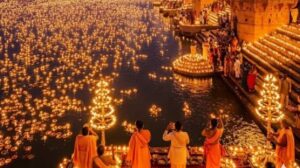Digital News Guru Uttar Pradesh Desk:
Dev Deepawali (also called “Dev Diwali”) in Varanasi
Every year, on the full-moon night of the Hindu month of Kartik, the city of Varanasi (also known as Kashi) puts on a breathtaking display of faith and light. This year, the celebration of Dev Deepawali falls on 5 November 2025 — and it is shaping up to be one of the most spectacular in recent memory.
Origins & Significance
The festival is tied to age-old Hindu traditions. According to one legend, on this day the god Shiva destroyed the demon Tripurasura and restored balance to the cosmos, so it is also known as Tripurari Purnima.

On this full moon (Purnima) of Kartik, it is believed the gods descend to earth and take a holy bath in the sacred river Ganga River, especially at Varanasi. To welcome them, thousands of earthen lamps (diyas) are lit along the ghats. The date is calculated by the Hindu lunisolar calendar: this year the full-moon tithi begins late on 4 November and continues into 5 November.
What to Expect in 2025
This year’s festival is being organised on a grand scale, blending age-old ritual with modern spectacle:
- The local tourism department plans to light around 10 lakh (one million) diyas along the Ganga’s ghats.
- A major new attraction: a 3D projection show titled “Kashi Katha” and eco-friendly green fireworks to add a technological edge to the spiritual celebrations.
- The festival this year is also being framed as a showcase of India’s cultural diversity: each ghat will reflect distinct regional traditions, under the theme “Ek Bharat, Shreshtha Bharat”.
- Efforts at sustainability: For example, women’s groups in Gujarat are producing hundreds of thousands of eco-friendly diyas from cow-dung for the event.
The Scene on the Ground
As dusk approaches, Varanasi transforms. From the renowned Dashashwamedh Ghat to lesser-known ghats, the riverbank glows with lamps, devotees gather, boat rides crowd the waters, and the Ganga Aarti takes over.

Families, pilgrims and tourists alike fill the ghats. Boats ply the river, each reflecting the shimmering lights of the shore. The air echoes with “Har Har Mahadev!”, conch-shells and drumbeats. @time of the Aarti, traffic on the Ganga itself may slow down or jam because so many boats are out.
Rituals & Traditions
- Holy Bath (Kartik Snan): Devotees take an early morning or pre-sunset dip in the Ganga, believed to wash away sins and bring blessings.
- Lighting of Lamps (Deep Daan): Earthen lamps are placed along the ghats, floated on the water, and lit in homes and temples. The timed muhurat this year is from about 5:15 pm to 7:50 pm.
- Ganga Aarti: Priests conduct the ritual of waving fire lamps in unison at Dashashwamedh Ghat and others, accompanied by hymns and musical instruments.
Cultural & Tourist Significance
While the festival’s spiritual dimension is paramount, Dev Deepawali has also emerged as a major tourism draw and economic stimulus for Varanasi:
- The “Mini Bharat” concept this year means visitors will see regional customs from across India represented on the ghats — from Marathi to Nepali traditions to Gujarati rangoli displays.
- The spectacle of a million lamps and laser shows is aimed at both domestic and international visitors, reinforcing Varanasi’s identity as a cultural-spiritual hub.
- Local crafts, food stalls and boat-ride businesses will all benefit from the increased footfall.

Local Preparations & Challenges
Preparations are extensive: cleaning and decorating ghats, coordinating light and sound, arranging boat rides and crowd control. Security measures are in place given the massive gathering.
But challenges remain: heavy crowds often mean access issues to certain ghats, logistics of boat traffic on the river can get congested, and the environmental impact of fireworks and lamp ashes must be managed. One recent initiative: the eco-diyas leave ash that can be used in farms after burning, reducing waste.
Why It Matters
Dev Deepawali is more than just a festival of lights. It symbolises the victory of light over darkness, good over evil (through the Tripurasura myth), and the descent of the divine into the everyday world. For Varanasi, it is a moment when ancient ritual meets urban energy, religion meets tourism, and devotion meets spectacle.
You May Also Read: Shashi Tharoor Warns: Dynastic Politics is a ‘Grave Threat’ to Indian Democracy








